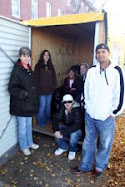Requests up, donations down at state's pantries, shelters
By MIKE CULLITY
New Hampshire Union Leader
Sunday, Nov. 16, 2008
Amid the struggling U.S. economy, the number of families requesting food from the Tri-County Community Action Program's five northern New Hampshire pantries has jumped drastically this year.
Each community food pantry has seen an increase of 20 to 50 percent in requesting families in 2008, said Phil Guiser, programs director for the Berlin-based organization that serves community needs across Coos, Carroll and Grafton counties. But the numbers tell only part of the story.
"People are telling me our clients are more distraught," Guiser said. "We're seeing more people who, when they tell their story, break into tears. . . . It takes a toll on our staff as well."
With winter approaching and Thanksgiving less than two weeks away, organizations across New Hampshire that provide emergency food and shelter are grappling to meet increased demand with depleted resources.
On Friday, the New Hampshire Food Bank had 205,000 pounds of food in its Manchester warehouse, executive director Melanie Gosselin said. Although that's up slightly from a mid-July low of 137,000 pounds, it's about 400,000 pounds less than typical late-fall levels, she said.
►How you can help meet the need
"Our inventory is up a little bit (from summer), but requests from the agencies we serve are up 40 percent this year," Gosselin said. "Our distribution is only up 24 percent, so there's still a big gap there."
In 2008 the food bank anticipates distributing 5.2 million pounds of food to more than 350 agencies throughout the state, Gosselin said. That's up from 4.3 million pounds in 2007.
But increased demand and last summer's high diesel fuel costs prompted the food bank to exhaust resources it would typically spend around the holidays. "We're playing catch-up," said Gosselin, adding that the food bank is working hard to fulfill 11,000 requests it has received for Thanksgiving turkeys.
Doing more with less
The Nashua Soup Kitchen & Shelter has averaged 20 new requests per week for food from its pantry over the past eight months, said Eileen Brady, a social worker there. And requests for Thanksgiving food boxes from the Riverside Christian Church Food Pantry in Merrimack are up 20 percent over last year, said Bill Davis, the pantry's administrator.
In Keene, the Community Kitchen this year has distributed between seven and 11 percent more food boxes per month than last year, said executive director Ann Davis. Even though the food pantry collects a million pounds of donated food per year, it has spent more than $100,000 on wholesale food purchases this year to supplement its donated supply.
First-time Food for Children volunteer John Harding of Manchester stacks flats of strawberries to be distributed to recipients at the "Food Drop" at the JFK Coliseum in Manchester yesterday morning. (BRUCE TAYLOR)
"We may have to stop purchasing food, because we're running out of money to do that," Davis said. And although the Community Kitchen can obtain food from the New Hampshire Food Bank for a delivery fee of 18 cents per pound, the food bank can't always fulfill its requests, she said.
As a result, the kitchen has stepped up its efforts to cultivate donations from food distributors and local businesses, Davis said.
But in these economic times, finding more donors is difficult. Like other agencies around the state, New Horizons for New Hampshire in Manchester has more people requesting food, but fewer donations.
"That is a concern for us," said program director Kevin Kintner.
New Horizons typically receives more donations around the holidays and is gearing up for that, Kintner said. But he worries about January and February, when donations traditionally slow down.
"Those would be the months we'd like to see more come in," he said.
Like food pantries, New Hampshire homeless shelters are wrestling with greater demand. In Rochester, all six bedrooms at the Homeless Center for Strafford County have been full since the second week of October.
"We're turning people away already, and we're not even in the cold part of the season," director Jan Walsh-grande said.
The Nashua Soup Kitchen and Shelter's two facilities, which have a total of 30 beds, are running at or near capacity, executive director Lisa Christie said. And although there's room at New Horizons' 76-bed shelter in Manchester, Kintner expects the vacancies won't last long.
"We're not full yet, but we're getting there," he said.
Times getting tougher
Several economic factors are fueling increased demand for emergency food and shelter in New Hampshire, observers said. In August, the U.S. Department of Agriculture forecast that food prices would rise by 5 percent to 6 percent in 2008, the largest annual increase since 1990.
Although gas prices have retreated from their summer highs, the temporary spike hurt many whose finances were already precarious. In the North Country, some elderly residents are still paying off last winter's heating bills, Guiser said.
Layoffs, reductions in hours, and less seasonal hiring have also driven people to seek relief.
"People who were borderline aren't anymore," Ann Davis said. "They were just staying afloat, but now it's getting to the point where they have nowhere else to turn."
"We see plenty of people who are employed," Brady added. "That's scary. Employment should bring some security, and it really doesn't."
Although the picture is bleak, it's not devoid of bright spots.
Last week, for example, an anonymous donor pledged to match all contributions to the Nashua Soup Kitchen and Shelter for the rest of the year, up to $500,000.
"It really helps us answer the question, 'Will we be able to feed everyone this year?'" Christie said.
NH Facts
Tuesday, November 18, 2008
Subscribe to:
Post Comments (Atom)




No comments:
Post a Comment